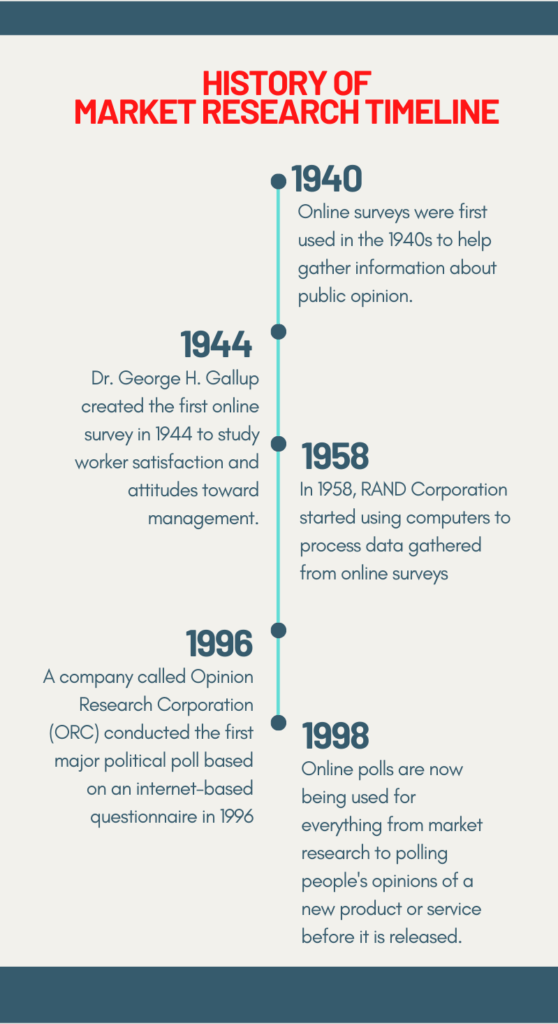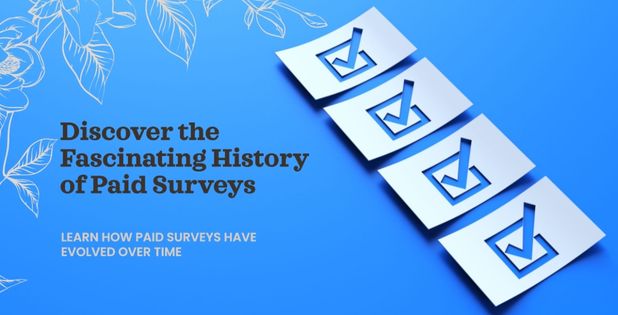History Of Paid Surveys A Simple (But Complete) Guide

10 Things Every Paid Surveys Taker Should Know
November 21, 2021
The 9 Benefits of Surveys Taker Vs Product Tester
December 10, 2021Many people are familiar with the idea of receiving money for filling out surveys.
However, they may not be aware that paid surveys have existed for decades.
 It began in the 1940s when George Gallup created an advertising company and started researching consumers via phone
interviews. 
This blog post will examine the history behind these types of studies and how they have evolved.
We love answering questions that matter to our members, so here’s the scoop.
A Quick History of Online Surveys
Paid surveys are a relatively new concept that has grown in popularity over the past few decades.
 They allow everyday people to participate in market research and other studies by providing their opinions on various topics,
such as products or services they have used before.
What they would buy if given funds, etc. By doing so, these individuals can receive payments for the time and input they have
provided which can go towards anything from groceries or bills to gifts for friends or family members.
History of Market Research Timeline

1. Online surveys were first used in the 1940s to help gather information about public opinion.
They have been a big part of our lives for a long time. 
The first online survey was created in conjunction with World War II. It helped government officials decide how best to allocate
scarce resources when many men were away at war or working as factory laborers.
However, there are other uses too such as market research which can help companies make more informed decisions about what
products might work well together.
Better understand customer needs so they know if their current line is being carried by stores adequately enough before risking
any investments into new lines entirely.
2. The first online survey was created by an American sociologist, Dr. George H. Gallup in 1944 
Dr. George H. Gallup created the first online survey in 1944 to study worker satisfaction and attitudes toward management.
A new form of data collection was needed because traditional methods like mail-in questionnaires or personal interviews were too
expensive for large companies with many employees working overseas during World War II. 
3. In 1958, RAND Corporation started using computers to process data gathered from online surveys
 The idea was that this would be more efficient than relying on humans who had limited time for comprehending large quantities
of information or abilities with complex calculations alone.
The first survey was conducted through a 2-minute questionnaire that asked respondents about their attitudes on nuclear
weapons testing and Communism to better understand public opinion surrounding these issues.
4. A company called Opinion Research Corporation (ORC) conducted the first major political poll based on an internet-based
questionnaire in 1996 
And it changed how we understand public opinion forever.
The research group used a new technology that allowed them to survey people from around America without having any
prearranged contact details for respondents which would make it easier than ever before possible to get their voices heard by
politicians at all levels of government – this helped ORCs succeed rate by over 90%.
 And they found that not only did most people have access to a computer in their home but also many had one at work or school
too!
This is huge for marketers because now you can track what consumers are doing online without having them come into your store
– which saves time (and money!)
This revolutionary development would forever change how Americans engage with their government, vote for candidates, and
news coverage of current events is heavily influenced by polls that are conducted using this innovative methodology
5. Online polls are now being used for everything from market research to polling people’s opinions of a new product or service
before it is released.
Online polls are becoming more and more common in the modern-day.
These days, you can find them being used for everything from market research to polling people’s opinions of a new product or
service before it is released 
This way, companies can get feedback on their ideas and incorporate this information into the design process which will lead them
to produce better goods than ever!
This type of interactive questioning can be especially effective in allowing many voices other than just one pollster’s opinion on an
issue since respondents will have their say and contribute information that isn’t available anywhere else!
Check This Related Content: 9 Creative Ways to Make Money Online
What are Paid Surveys and Why are they Popular?

Paid surveys have become an increasingly popular way for people to make extra money from the comfort of their own homes.
From stay-at-home parents and college students to individuals looking to supplement their income, paid surveys offer a simple
and convenient opportunity to earn some cash.
But what exactly are paid surveys?
Essentially, they are market research tools used by companies and organizations to gather consumer opinions and feedback on
products or services.
What makes paid surveys so appealing is their accessibility and flexibility.
Unlike traditional part-time jobs, with paid surveys, individuals can work whenever and wherever they want.
Whether it’s during lunch breaks, before bed, or while waiting in line at the grocery store, anyone with a smartphone or computer
can participate in these surveys.
Additionally, since there is no minimum time commitment or set schedule required for completing them, participants have full
control over how much time they dedicate to taking surveys.
Another reason why paid surveys have gained popularity is their potential for financial rewards.
While not all survey platforms offer high-paying opportunities, some do provide generous compensation for participants’ time and
effort.
This means that individuals who take the time to seek out reputable survey sites can potentially earn a decent amount of money
each month by simply sharing their opinions.
Moreover, people appreciate that participating in paid surveys often allows them to contribute directly to shaping future products
and services.
Their voices serve as valuable insights for companies looking to improve existing offerings or develop new ones.
The opportunity to be heard and play a small role in influencing consumer experiences lends a sense of empowerment and
importance to survey participants.
The Early Beginnings of Paid Surveys

Before the internet emerged as a global platform for connecting people, paid surveys already had their roots in traditional market
research.
In the early beginnings of this practice, companies would gather consumers in focus groups and conduct face-to-face interviews to
gather valuable feedback and insights.
This approach was effective but limited in reach and time-consuming.
However, with the rise of technology and the growing accessibility of computers, paid surveys took a giant leap forward.
Research agencies started using computer-assisted telephone interviewing (CATI) systems to conduct surveys over the phone.
This method allowed them to reach a larger audience and collect data more efficiently.
Respondents could share their opinions from the comfort of their own homes or offices.
CATI systems represented a significant advancement at the time, setting the stage for future developments in online paid survey
platforms.
As computers became increasingly prevalent, businesses quickly realized that they could leverage this technology to streamline
market research even further.
By partnering with software developers and online service providers, they created web-based survey platforms that made it
possible to reach thousands of potential respondents simultaneously.
These platforms revolutionized paid surveys by enabling anyone with internet access to participate in market research studies
from anywhere in the world.
With user-friendly interfaces and digital incentives like gift cards or cash rewards, these online survey panels rapidly gained
popularity among both consumers looking to make some extra money and companies seeking valuable consumer insights.
The Rise of Online Paid Surveys

In recent years, there has been a significant rise in the popularity of online paid surveys.
This can be attributed to several factors:
- one of which is the increasing accessibility of the internet and mobile devices. With more and more people owning smartphones or having access to computers, participating in online surveys has become easier than ever before.
- Another reason for the surge in online paid surveys is the changing landscape of work. Traditional employment is no longer as stable or secure as it once was, and many individuals are seeking additional sources of income to supplement their earnings. Online paid surveys offer a convenient way to earn money from the comfort of one’s own home, making them an attractive option for those looking to make some extra cash.
- Furthermore, advancements in technology have made it possible for market research companies to collect data faster and more efficiently through online platforms. The speed at which surveys can be conducted and responses gathered allows businesses to make quick decisions based on consumer feedback.
- Additionally, by using online surveys, companies are able to reach a larger pool of potential participants from diverse backgrounds, leading to more accurate and representative data.
Overall, the rise of online paid surveys is a testament to the changing dynamics in our society.
As technology continues to advance and people search for alternative ways of earning income or expressing their opinions, we can
expect this trend to continue its upward trajectory.
So if you’re looking for an easy way to earn money or have your voice heard by brands and businesses alike, participating in online
paid surveys might just be worth considering!
Conclusion
 We hope you have enjoyed the history of paid surveys and know more about how they came to be. 
If you liked this post please consider joining us or sharing it with others so that we can all learn together.
References
https://www.surveylab.com/en/blog/online-surveys-short-history/
https://www.irazoo.com/blog/a-quick-history-of-online-surveys/
https://resources.pollfish.com/market-research/online-survey-platforms-history/
https://www.uvm.edu/~dguber/POLS234/articles/groves.pdf
https://www.askattest.com/blog/articles/history-of-market-research
https://www.keltonglobal.com/perspectives/a-brief-history-of-market-research/




